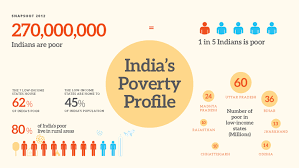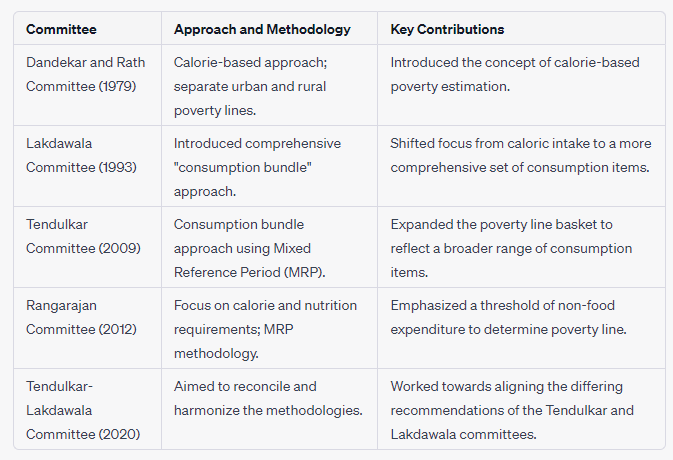
Table of Contents
What is Poverty?
According to the World Bank, Poverty is the state of inability to acquire the basic goods and services necessary for survival with dignity.
If we talk in Indian context, Dada Bhai Naoroji through his book, “Poverty and un-British Rule in India” made the earliest estimation of the poverty line. The poverty line proposed by him was based on the cost of a subsistence or minimum basic diet (rice or flour, dal, mutton, vegetables, ghee, vegetable oil, and salt). This was termed as the jail cost of living.
How Poverty is calculated?
- Poverty Line: A poverty line is a threshold income or consumption level that is considered the minimum required to meet basic needs. India uses both rural and urban poverty lines, which are periodically revised to account for inflation and changing consumption patterns. These poverty lines serve as benchmarks to categorize households as poor or non-poor.
- Data Sources: Data for poverty estimation primarily come from large-scale surveys conducted by the government, such as the National Sample Survey (NSS) and the Socio-Economic and Caste Census (SECC). These surveys collect information on household consumption patterns, income, and other socio-economic indicators.
- Consumption Expenditure: The most common method used for poverty estimation in India is based on consumption expenditure. Households’ consumption patterns are used to estimate their income levels and determine whether they fall below the poverty line.
- Poverty Measures: Two commonly used poverty measures in India are the Headcount Ratio (percentage of people below the poverty line) and the Poverty Gap Index (measuring the depth of poverty). These measures provide insights into the severity and distribution of poverty.
- Calculation and Analysis: Poverty estimation involves calculating the number of individuals or households below the poverty line and analyzing the distribution of poverty across different demographic groups, states, and regions. It helps identify disparities and target interventions.
- Social Indicators: In addition to consumption-based measures, poverty estimation may also consider various social indicators such as health, education, and access to basic services to provide a comprehensive view of well-being.
It’s important to note that poverty estimation is a complex and evolving process, subject to methodological debates and challenges. Different approaches to poverty estimation can yield different results, and there is ongoing discussion about the accuracy of data collection methods, the choice of poverty lines, and the appropriateness of various measures.
Committees for Poverty Estimation
Several committees have been formed in India over the years to review and recommend methodologies for poverty estimation, improve data collection, and enhance the accuracy of poverty measurement.

These committees have played a significant role in shaping the methodologies and approaches used for poverty estimation in India. They have contributed to refining the understanding of poverty, accounting for changing consumption patterns, and improving the accuracy of data collection methods. However, the methodologies and poverty lines suggested by these committees have also faced criticism and debates, reflecting the complexity of measuring and addressing poverty in a diverse country like India.
Challenges in Poverty Estimation
The poverty estimation in India is not without its challenges. One of the biggest challenges is the lack of accurate and reliable data. The data collection process in India is often fragmented and inconsistent, leading to inaccuracies in poverty estimation. Additionally, poverty estimation based on the poverty line method does not take into account the regional differences in the cost of living. This can result in underestimation of poverty in some regions.
Another challenge is the lack of a consistent and widely accepted definition of poverty. There is no consensus on what constitutes poverty, and different agencies and organizations use different criteria to define poverty. This can lead to confusion and inconsistencies in poverty estimation.
Poverty Estimation in Rural and Urban Areas
The poverty estimation in rural and urban areas is done using different poverty lines. The poverty line for rural areas is lower than the poverty line for urban areas, as the cost of living is lower in rural areas. Additionally, the poverty estimation in rural areas is more challenging, as the data collection process is often more difficult in rural areas.
In recent years, there has been a significant reduction in poverty in urban areas, while poverty in rural areas has remained stubbornly high. This is due to various factors such as the lack of access to education and healthcare, and the absence of employment opportunities in rural areas.
Effect of Poverty on Education and Health
Poverty has a significant impact on education and health in India. Children from poor families are less likely to attend school, and those who do attend school are more likely to drop out early. Poverty also affects the quality of education that children receive, as poor families are often unable to afford quality education for their children.
Poverty also affects the health of individuals and families. Poor families are more likely to suffer from malnutrition and other health problems due to the lack of access to healthcare and nutritious food. Additionally, poor families are less likely to seek medical treatment when they fall ill, as they cannot afford the cost of medical treatment.
Conclusion
Poverty estimation is a crucial aspect of poverty reduction in India. While poverty estimation methods such as the poverty line method, the multidimensional poverty index, and the human development index are widely used, they are not without their challenges. The lack of accurate and reliable data and the absence of a consistent definition of poverty are some of the challenges faced in poverty estimation.
The Government of India and various state governments use poverty estimates to design and implement poverty alleviation programs, such as the National Rural Employment Guarantee Scheme (NREGA), food distribution programs, education initiatives, and healthcare interventions, with the aim of reducing poverty and improving the quality of life for disadvantaged populations.
Important Links